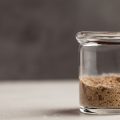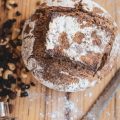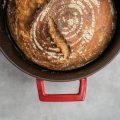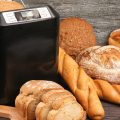If you’re new to sourdough baking and aren’t quite familiar with banneton baskets, or proofing baskets in general, then fear not. With this easy-to-follow guide, you’ll be ready for sourdough bread proofing in no time! Here’s my guide on how to use a banneton (or how I do it anyway!).
![How To Use A Banneton: Learning Proofing Basics 1 How to use a banneton [easy to follow guide]](https://www.mydailysourdoughbread.com/wp-content/uploads/2023/01/blog-images-15-1-720x405.jpg)
Table of Contents
- What Is A Banneton Basket & Why Do You Need One?
- Choosing the Right Banneton
- How to Prepare A New Banneton Basket
- How To Use A Banneton Proofing Basket For Sourdough
- How To Clean A Banneton Basket
- How To Store Banneton Proofing Baskets
- Alternatives to Banneton Baskets
- Banneton Troubleshooting
- So How To Use A Banneton Basket?
- FAQs
What Is A Banneton Basket & Why Do You Need One?
A banneton basket is a small basket made from rattan or wood pulp and is often used to hold the shape of sourdough bread dough. It’s important for sourdough to have a shaping container; without it, the dough will spread awkwardly during the proofing stage.
Banneton baskets are specifically built and shaped for artisan-style bread, enabling the dough to breathe during the proofing process.
If you’ve ever wondered where sourdough bread gets its spiral pattern from then take a look at your banneton basket. The basket prints its rings onto the dough whilst proofing.
If you want your sourdough bread to be shaped in a certain way, then you can choose any type of banneton basket you like, from triangular, to oval, you can go for anything you fancy!
- BANNETON BASKET: Holds 1.5 pounds of dough with 9 inch (D) x 3.5 inch (H) size, works well with any recipe involving Flour Water Salt and Yeast such as Lahey No Knead, Tartine Country, Glutenfree recipes, and our banneton basket is capable of proving overnight in the fridge with a tightly cover bag.
- HANDMADE WITH NATURAL RATTAN CANE MATERIAL: The bread proofing basket is made from natural rattan, free from dye and chemicals. Dough can be removed and released nicely.
- EASY TO CLEAN: After using the banneton proofing basket, remove any excess flour or dough from the basket, and store the basket in a cool and dry place after it dry completely prevent it from going bad.
- EASY TO USE: This banneton bread basket set is helpful for bakers and people who like to make fresh and healthy bread by themselves.
- SnailDigit provides premium-quality products good customer service. If you are not satisfied with the bread proofing basket, contact us within 30 days, well help you solve it.
Prices pulled from the Amazon Product Advertising API on:
Product prices and availability are accurate as of the date/time indicated and are subject to change. Any price and availability information displayed on [relevant Amazon Site(s), as applicable] at the time of purchase will apply to the purchase of this product.
Choosing the Right Banneton
When selecting a banneton-proofing basket for your sourdough baking, there are a few key factors to consider.
Size
The size of the banneton impacts how much dough it can hold. Bannetons come in a range of sizes from small 6-inch rounds up to large 14-inch ovals. A larger basket is useful if you regularly bake multiple loaves or make large boules. Smaller baskets around 8-10 inches typically work well for most home bakers’ needs. Think about your usual batch size and bread shape preferences when choosing a size.
Material
The material affects airflow, durability, and aesthetics. Traditional bannetons are woven from natural rattan or wood pulp. These materials allow airflow and leave a distinctive patterned imprint on the dough. Plastic and metal bannetons are also available. Bannetons with linen or cloth liners make it easy to release loaves without deflating. Wood pulp bannetons tend to be more durable and hold their shape better over time. Rattan imparts an organic artisan look but can crack if not cared for properly.
Shape
Bannetons come in round, oval, square, and triangular forms to suit different aesthetic bread shapes.
- Round baskets work well for boules.
- Oval baskets create oval loaves, which many bakers feel makes better sandwich slices.
- Square baskets produce square-sided batards with a softer crust.
- Triangle bannetons create a corkscrew spiral effect.
An 8-10 inch oval rattan banneton with linen liner makes a great starting point for most home bakers. And you can build up a collection over time to create different looks!
How to Prepare A New Banneton Basket
When you’ve purchased a brand new banneton basket, ready to get to sourdough shaping, there are a few things you need to do before slapping your dough into the spiral patterned basket.
Firstly, before you place your dough into the banneton, make sure that the labels are removed. Lightly spray the banneton basket with water, and dust the entire banneton with some rice flour.
Once the basket is dry, gently tap out any excess flour over the bin. Your banneton should be ready for some bread dough.
Do You Need A Banneton Liner?
Most bannetons come with a cloth or linen liner, and these liners are devised to rest inside the banneton, then the dough is placed on top of the liner. However, having a liner in the banneton isn’t an absolute necessity, and is generally better without it.
Additionally, if you’re not a fan of the banneton spirals, you could always place the liner in the basket before proofing. The banneton liner will guarantee a smooth finish once you flip it out. This is especially great for scoring shaped dough with any type of pattern you want.
Before you can place dough on top of the liner, it’s important to coat it with rice flour. The easiest way to do this is to take some rice flour and gently rub it all over the cloth so that it doesn’t stick to the dough.
- 【Baking essensile】Practical and must-have items for baking beginner and skilled people, work well at proofing and absorbing the moisture from the dough for the crispy round crust, help to make the healthy smooth and clean dough. Excluding baskets
- 【General size】10 Inch size fits for most bread banneton round proofing basket. Can accompany you a long time. Satisfying your different demands and suitable for many sizes of bread proofing basket.
- 【Reliable material】Smooth surface and nice texture. Made of untreated flax linen and cotton fabric, Great quality material with good workmanship. Durable and soft, Made out of natural material, safe for your use.
- 【Easy to use 】Nice partner with bread proofing basket (not included), just place the kneaded dough into the proofing basket and cover the proofing basket cloth liner, once it has sufficiently risen, unmold the loaf and transfer it onto a baking pan.
- 【Great value package】You will receive 6 pieces of Dough Basket Cover Natural Rattan Banneton Proofing Cloth. Enough quantity for satisfying your baking supplies demand and replacement. Color: as pictures showed.
Prices pulled from the Amazon Product Advertising API on:
Product prices and availability are accurate as of the date/time indicated and are subject to change. Any price and availability information displayed on [relevant Amazon Site(s), as applicable] at the time of purchase will apply to the purchase of this product.
Best Flour For Prepping A Banneton Basket
Rice flour is probably the best type of flour you could use to dust your banneton with. It’s also a type of gluten-free flour which is a bonus.
Unlike wheat flour, bread flour, or all-purpose flour, rice flour doesn’t absorb moisture, which makes it the best choice for a banneton.
Rice flour is incredible, as it prevents the dough from sticking to the banneton, and creates an additional mess for home bakers to clean up. You can use all-purpose flour if you wanted to, but since it contains gluten, it can potentially cause all sorts of disasters. For starters, the dough will cling to the inside of the banneton, especially if it’s been dusted with all-purpose flour.
If you don’t have any rice flour, you can always substitute it for semolina flour.
Using the Wrong Flour in the Banneton
It’s crucial to use the proper type of flour when seasoning and storing your banneton-proofing basket. Flours containing gluten like wheat or bread flour can cause major sticking issues and mess up your beautiful boules.
I strongly advise avoiding all-purpose, whole wheat, bread, or any gluten-containing flour in your banneton. The gluten develops sticky proteins that cling to the basket ribs. And good luck getting that gummy dough to release cleanly after proofing!
While other gluten-free flours like tapioca or cornstarch will also prevent sticking, rice flour’s ultra-light texture makes it ideal for bannetons. Don’t chance dough disasters – rice flour is the foolproof choice!
![How To Use A Banneton: Learning Proofing Basics 5 How to use a banneton [easy to follow guide]](https://www.mydailysourdoughbread.com/wp-content/uploads/2023/01/blog-images-18-1-720x405.jpg)
How To Use A Banneton Proofing Basket For Sourdough
Using a banneton basket for sourdough is pretty straightforward. Once the basket is prepared, you can instantly use it to hold the dough.
- Place the dough into the banneton basket seam side up.
- Once comfortably nestled in the basket, sprinkle rice flour around the edges. This is especially great for sticky dough, as it prevents the dough from sticking to the liner and sides of the banneton. Although, if the dough has been shaped correctly, you shouldn’t require too much rice flour.
- Then let the dough proof at room temperature or in the fridge.
How To Clean A Banneton Basket
When it comes to banneton baskets, it’s important that they are kept clean. You wouldn’t want fragments of dried dough, and old rice flour, sticking to your fresh dough now would you?
That being said, you don’t have to necessarily wash them after each use, unless there’s dough stuck to the basket.
Once your sourdough is placed in a Dutch oven to bake, tap the back of the banneton over a bin, to get rid of any excess flour. With the excess flour eliminated, you can simply air dry the basket before putting it away.
Should You Wash Banneton Baskets?
Normally you don’t need to wash your banneton baskets, as the cleaning method specified should suffice. However, if you happen to have some hardened dough sticking to your banneton, then you can always rinse it under cold water, and use a stiff brush to help clean the sticky dough inside.
When the basket is clean, use a clean towel to get rid of the water droplets, until you’re left with a relatively damp banneton basket. Then let the basket dry out.
How To Store Banneton Proofing Baskets
Banneton baskets should be stored in a cool dry place, with enough airflow to help avoid the risk of mold.
Once the banneton is nice and dry, you can keep them on top of a cupboard near the kitchen so that there is enough air flowing between them.
Do You Oil a Banneton?
When caring for a banneton, it’s common to wonder if oiling the basket is recommended. Applying oils can provide some benefits but also risks. Lightly coating the basket’s interior with olive or vegetable oil creates a non-stick barrier to prevent dough from adhering during proofing. However, oil can penetrate and soften the basket fibers over time, causing cracks. Oil may also impart an unpleasant flavor to the bread dough. For optimal banneton care, rice flour is the best choice – simply mist the basket with water before each use and dust rice flour over the damp surface.
Can I Put My Banneton Basket in the Oven?
With sourdough baking, a key question arises – can I put my proofing basket in the oven? Many bakers wonder if bannetons can withstand oven heat. The short answer is no.
Most rattan, wood pulp, plastic, or metal bannetons cannot tolerate high baking temperatures. Their materials will burn, melt, or release toxic fumes around 350°F and above. An oven’s dry heat can also cause the basket fibers to become brittle and crack over time.
Instead, seamlessly transfer the risen dough from the banneton onto a pizza peel, then slide it directly into the preheated Dutch oven or baking vessel. This protects your basket and beautifully bakes the bread, leaving the banneton’s circular patterns imprinted on the crust. With good technique, there’s no need to risk damaging your precious proofing basket!
![How To Use A Banneton: Learning Proofing Basics 6 How to use a banneton [easy to follow guide]](https://www.mydailysourdoughbread.com/wp-content/uploads/2023/01/blog-images-16-1-720x405.jpg)
Alternatives to Banneton Baskets
If you don’t have a banneton basket, there’s no need to fret, because you can easily use something else instead.
While banneton baskets are extremely resourceful, there are other great baskets to go for:
- A kitchen colander with a cloth
- Plastic ricotta baskets
- Mixing bowl lined with cloth
Essentially, you can use anything you like to hold the shape of your sourdough during its proofing stage.
You must ensure, however, that the container you have chosen will also fit inside the Dutch oven, as this will also indicate that your dough will fit without any problems.
The best type of cloth you could use to line your shaping container is a thin 100% cotton fabric, i.e., an old pillowcase. Simply cut it down to the shape you need.
Ensure that the cloth is coated in rice flour before lowering your dough onto it, to prevent the proofed dough from sticking.
For more alternatives to banneton baskets, take a peek at some of these resourceful proofing basket alternatives.
Banneton Troubleshooting
If your dough is sticking to its proofing basket, then it’s likely that there is not enough flour in the basket. Ensure that your proofing basket is coated in rice flour before you place the dough into the basket.
Another common sourdough baking problem, is the dough becoming flat once it has been removed from the proofing basket. This could be due to a high hydration dough, or that the dough doesn’t have sufficient surface tension built during the shaping stage.
To avoid this, try a recipe with a hydration level below 75%, and take your time on the final shaping stage, pulling the dough to create nice and tight skin.
There’s Mold In My Proofing Basket!
If you ever notice mold in your banneton baskets, don’t panic. Simply place them in a preheated oven for 30-40 minutes at 250 degrees F to eliminate the mold.
So How To Use A Banneton Basket?
Baking bread and banneton baskets almost go hand in hand. If you’re aiming for a perfectly shaped loaf, then make sure you have a well-floured proofing basket somewhere in your kitchen!
FAQs
How Do You Use A Banneton For The First Time?
The first time you use a banneton there are a few essential steps you need to take. Firstly, you must lightly spray the basket with some water, then add a generous dusting of rice flour.
Do You Cover The Banneton When Proofing?
Yes. once the dough is in the banneton, it’s important to cover the dough to prevent the top of the dough from hardening. The dough can be covered with a damp towel or plastic wrap.
How Do You Use A Banneton Without A Liner?
If you don’t want to use a liner, then you must make sure that the basket is thoroughly coated with rice flour.








